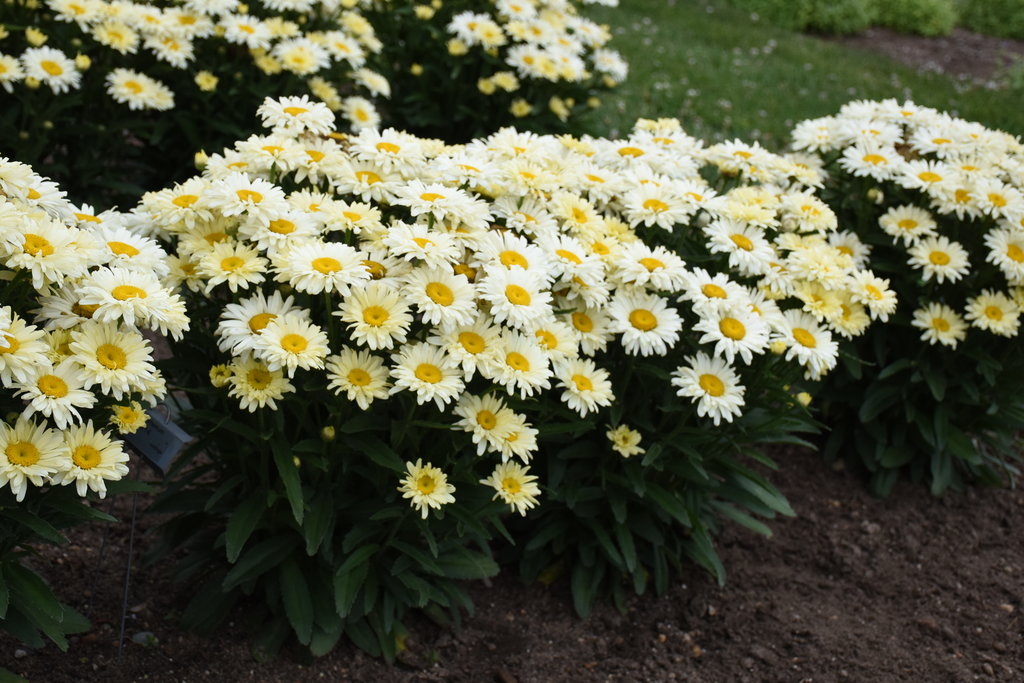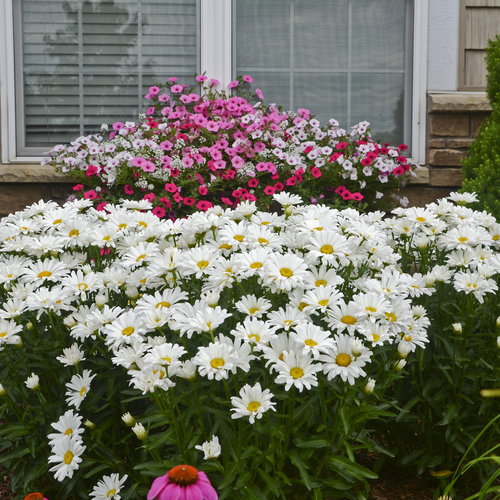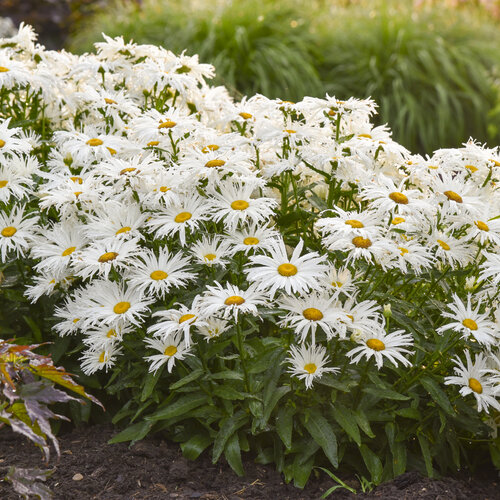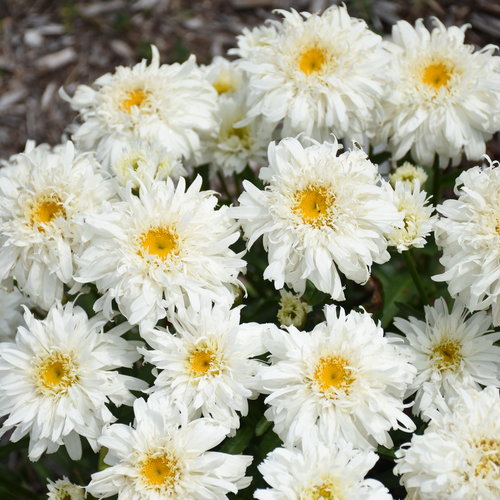Shasta Daisy - The Ultimate Growing Guide from Proven Winners®
Grow this classic flowering favorite for months of color in the summer garden.
Buy Shasta daisy plants - Order online and have them shipped right to your door
Shasta daisy (Leucanthemum x superbum) is a hybrid flowering perennial named for Mount Shasta in California where it was developed, and for the snowy white petals. The cheerful flowers are characterized by rays of petals surrounding a sunny yellow center. Hardy to USDA zones 5-9, this carefree perennial produces dark green toothed foliage that remains evergreen in milder climates. Shasta daisy bloom time ranges from early summer to early fall.
These improved daisies are more robust, with larger flowers and a longer bloom time than their wild counterparts. There are dozens of varieties, with different plant sizes and single or double flowers. Their height can vary from 6 to 48 inches tall in sizes suitable for small urban lots or spacious properties. The sturdy stems and long vase life make Shasta daisies superb cut flowers.
SHASTA DAISY CARE & PLANTING
How to plant: Grow Shasta daisies on a site that receives at least 6 hours of full sun per day. Follow these steps and plant them 1 to 2 feet apart, depending on the variety.
- Loosen soil in the planting area and amend with compost or other organic matter.
- Dig a hole twice as wide and slightly deeper than the root ball.
- Remove plants from their nursery pots and gently tease out roots if potbound.
- Set the plant in the hole with top of the root ball level with the surrounding soil.
- Backfill the hole with soil, tamp down slightly to remove air pockets and water well.
- Water plants regularly until established.
Soil: Shasta daisy prefers well-amended soil that drains well. Poorly draining soil can lead to root rot. In pots, use a high quality all-purpose potting mix.
Watering: Provide an average amount of water. Soggy soil can lead to root rot. Shasta daisy is moderately drought tolerant once established. Water more frequently during prolonged heat or dry spells.
Fertilizing: In spring, spread a thin layer of compost around the base of plants or apply a slow-release all-purpose fertilizer. Alternatively, use a water-soluble fertilizer monthly during the spring and summer.
Overwintering: In colder regions, plants will benefit from winter protection. After cutting plants back in fall, apply several inches of mulch over the crown to insulate plants from extreme cold.
TRY THESE PROVEN WINNERS® VARIETIES
Shasta daisies come in different forms, color shades and sizes. Try these varieties in your landscape:
|
|
|
|
SHASTA DAISY FAQ’s
Are Shasta daisies perennials? Do they come back every year?
Shasta daisy is a short-lived perennial that comes back each year. Regular division will promote vigor and extend their lifespan.
Do deer eat Shasta daisies?
Deer should avoid Shasta daisies due to their scent, bitter taste and prickly leaf texture. But, if hungry enough, deer will eat almost anything if other food sources are scarce.
Do Shasta daisies spread?
When grown in their preferred environment, your clump of daisies will expand each year. If you'd like, you can divide the clump and transplant the divisions to other parts of your garden.
What months do Shasta daisy plants bloom?
Bloom time can vary according to plant variety and region. In general, Shasta daisies bloom from June until September with regular deadheading.
What is the difference between a daisy and a Shasta daisy?
The term “daisy” is often used for plants with daisy-like flowers. Shasta daisy is arguably the best known type of daisy, with a classic flower form that’s universally recognized.
How long do Shasta daisies last?
When plants are regularly deadheaded, bloom time can last for several months. Individual flowers can last for a week to 10 days, making them a superb cut flower.
Should Shasta daisies be cut back?
Pruning Shasta daisies should occur in fall when plants are finished blooming. Cut the stems back to the base.
Do I deadhead Shasta daisies?
Deadheading Shasta daisies regularly will prolong bloom time. Learn more about why and when to deadhead your flowers.
Are Shasta daisies good for pollinators?
The flowers of Shasta daisy are attractive to bees, butterflies and other insect pollinators.
Where is Shasta daisy native?
Developed by American hybridizer Luther Burbank of Northern California, Shasta daisy is a hybrid of oxeye daisy and other species from Europe and Japan.
What is eating my Shasta daisies leaves?
Insect pests that may feed on Shasta daisy leaves include earwigs, slugs and aphids. If there is visible foliage damage, inspect leaves closely for signs of these pests.
Why is my Shasta daisy not blooming?
A number of factors can affect bloom, including overcrowded plants, not enough light, improper fertilizing, overwatering, root rot and temperature extremes.
Can Shasta daisies be grown in pots?
Shorter varieties are suited to containers, while standard varieties which can reach up to 4 feet tall are best grown in the ground.
Can Shasta daisies be divided?
Shasta daisies bloom best when they are divided every 2 to 3 years. Signs that it’s time to divide your plants include fewer blooms, less plant vigor or when the center of the clump dies out. Divide plants in early spring. In warmer regions, plants can also be divided in fall after plants are finished blooming.
Will Shasta daisies bloom the first year?
Plants grown from clumps will flower in their first growing season. If grown from seed, plants will flower in their second growing season.
SHASTA DAISY LANDSCAPE DESIGN IDEAS
There are many ways to use these flowers in your landscape. Here’s how:
- Plant in a mixed border along with other summer flowering perennials such as these Perennials with a Sunny Disposition.
- Grow in a cut flower garden alongside other summer bloomers such as dahlias, coneflower, zinnias, gladiolus and sunflowers.
- Include them in a pollinator garden with other plants such as aster, milkweed, bee balm, blazing star and tickseed. Here are 26 Yellow Plants for Bees.
- Plant a dwarf variety in a container by itself or alongside other plants with similar growing needs such as heuchera, calibrachoa and salvia.
- Mass a smaller variety in a bed or along a slope for weeks of continuous color.
- Use a shorter variety to edge pathways and borders.
- Create a moon garden with Shasta daisy and other plants with white flowers or silver foliage to enjoy on warm summer evenings. Here are 25 White and Silver Plants Perfect for Creating Moon Gardens.
- Plant Shasta daisies near a black walnut tree, which can be a problem area for many other plants. Learn what else to plant near black walnut trees.
SHASTA DAISY COMPANION PLANTS
The white and yellow flowers of Shasta daisy pair well with most other colors. Combine with other plants with similar cultural needs of full sun and well-draining soil.
For a mixed border, plant alongside:
For a pollinator garden, combine with:
- ‘Leading Lady Plum’ bee balm
- Decadence® 'Lemon Meringue' false indigo
- 'Scentsation' honeysuckle
- Rockin'® Playin the Blues® salvia
For a cutting flower garden, plant with:
- ‘Firefly Peach Sky’ yarrow
- 'Serendipity' ornamental onion
- Invincibelle® Ruby smooth hydrangea
- Suncredible® Yellow sunflower
Buy Proven Winners plants:









